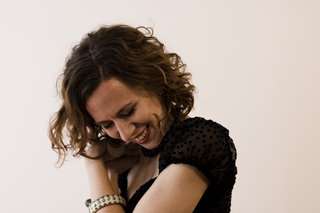|
Back
Louis’ Gang New York
Zankel Hall, Carnegie Hall
04/09/2010 -
Orchestra Underground: Louis & the Young Americans
Louis Andriessen: Symphony for Open Strings (NY Premiere)
John Korsrud: Come to the Dark Side (World Premiere)
Missy Mazzoli: These Worlds in Us (World Premiere, new orchestration)
Michael Fiday: Gonzo Variations (Hunter S. Thompson in memoriam) (World Premiere)
William Anderson (electric guitar), John Korsrud (trumpet)
American Composers Orchestra, Jeffrey Milarsky (conductor)

L. Andriessen (© Francesca Patella)
The Dutch composer Louis Andriessen has been mentor and teacher to so many American composers that he was labelled last night a modern Nadia Boulanger. Like Ms. Boulanger, Mr. Andriessen never insists that his students compose in a single way, and three of them showed their diverse styles alongside their master last night.
True, Louis Andriessen is best known as a composer, and a full week of his works will be heard in New York. That gives time to survey a man who has a diversity, not only of styles but of challenging himself with each new work. They have included the metaphysical (he has attempted to explain “time”), philosophical (a grand musical epic on Plato’s Republic), and classical literature (his opera, Divine Comedy is offered this Friday in Carnegie Hall).
Last night, though, the composer set a musical goal more caper than a challenge. Briefly, 12 string instruments would tune differently, then play a complete work on the open strings. The caper was ingenious, yes. But its worth was questionable. By not using the left hand, we had 12 excellent string players bowing without vibrato, without nuance, creating sounds somewhere between a 17th Century reed organ and (gasp!) and accordion. Moreover, at 25 minutes, Mr. Andriessen wore out his welcome fairly quickly, even with some inventive little musical cells.
A quack pedagogue might say that Mr. Andriessen, by using sections of organum roots, varying and repeating them, was going back to his medieval Flemish roots. The reality was that each of the continued sections would start with a three- or four-note interval, then surround itself with orchestral density.
The opening was ingenious, the orchestra bowing (what sounded like) five different pitches, almost imperceptibly, then broadening out to each key. Another section was loveably ludicrous. I am thinking of a duet for the two double-basses (tuned one interval apart), playing delicious duets in an awkward oom-pah rhythm, followed by the string orchestra. Mainly, though, Mr. Andriessen was much quieter, much more subtle. I imagine he has a mathematical rationale for the work, as he does in De Tijd (Time), but his offering here, on the surface, had a blandness leading toward the vapid.
The following work was–literally–a breath of fresh air after the hermetic opening. That fresh air came from trumpet-player John Korsrud, playing his own Come to the Dark Side. The captivating title comes from an Andriessen quote to Mr. Korsrud about musical theory, but the trumpet-player/composer transposed it into an eerie–and later blazing–tribute to Oriental mysticism.
The beginning, at least, was ersatz Eastern. Along with a tattoo of gong and bass drum, the strings played a metallic clatter against Mr. Korsrud, playing pentatonic scales, often with bluesy little riffs. The orchestra played without him for awhile, with energetic pulsing rhythms. The trumpeter returned going into the stratosphere, Gillespie style, followed by a strange slow ending. Unlike the other three pieces, Mr. Korsrud composed with an energy, confidence and honestly inventive effects.

M. Mazzoli (© Francesca Patella)
After the intermission, a short video was shown of Missy Mazzoli discussing her need to be a composer, along with her own ensemble. The live music was the most conservative work of the evening, a lyrical piece with recurring bells and instrumental calls, based on a poem by James Tate.
A questionnaire in the program asks listeners, “If you were Hunter S. Thompson, what would you write about this concert?” They were referring to the final work, Michael Fiday’s Gonzo Variations, dedicated to the late great writer. The variations were on two themes. One from Jefferson Airplane’s White Rabbit, the other from Stephen Foster’s Old Kentucky Home.
(Yes, Mr. Thompson was born in Louisville, and, like Stephen Foster, he died all too young from over-imbibing, amongst other things, the Demon Rum.)
With an excellent electric guitar solo by William Anderson, and a very involved set of variations on both themes, Mr. Fiday showed that he has a mastery and respect for complex counterpoint, this probably from Louis Andriessen. But were these truly “Gonzo” variations? Would Mr. Thompson have enjoyed hearing his words (partly spoken at the end) set to a musical pattern?
Immodestly, I confess than, when living in Bangkok, I played host to Hunter Thompson several times when he was returning from Vietnam. In talk, as well as writing, he was intense, vivid, informed, less opinionated than incredibly curious, but most of all, he was direct. Nothing came between his words, his ideas, his attempts at solving the puzzles of man(un)kind.
So back to Mr Fiday’s work. Mr. Thompson appreciated those rare folks who create, but methinks he would have found the piece contrived, cunning and perhaps a little too cagey for his own unique look at the universe. This was not Michael Fiday’s fault. But holding a musical mirror to Hunter Thompson ‘s words, must inevitably produce a blurred and inchoate image.
Incidentally, nothing was blurred or bland about the American Composers Orchestra. Jeffrey Milarsky is one of those singular conductors who can take the most eclectic forms in a concert and generate an excitement frequently greater than the music deserved.
Harry Rolnick
|